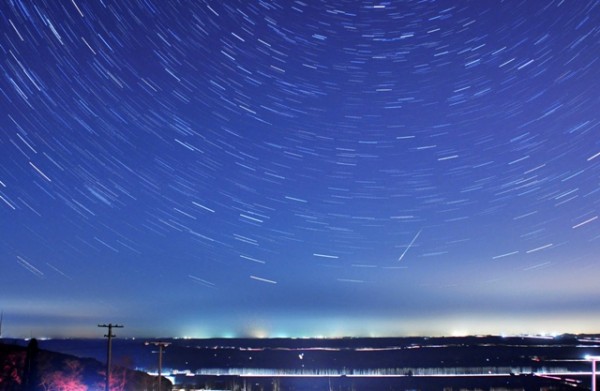Spectacular Jupiter and Big Dipper Meteor Shower all in January 2015
| Marco Foronda | | Jan 01, 2015 07:31 AM EST |
(Photo : REUTERS/Stringer) A meteor streaks past stars during the annual Quadrantid meteor shower in Qingdao, Shandong province, January 4, 2014
January nights will showcase the planet Jupiter in the constellation Leo. The Quadrantid meteor shower will be active in the first week of January some 10 degrees northwest of Leo's brightest star, Regulus.
The gas giant Jupiter will rise at around 8:00 p.m. and will linger for about 20 minutes after sunset by the end of January. Jupiter is approaching opposition on Feb. 6.
Like Us on Facebook
It will be a magnificent phenomenon throughout January in telescopes and binoculars. Jupiter will appear highest in the south after midnight.
Aside from Jupiter showcasing its beauty, there will also be the Quadrantid meteor shower that will peak during the hours before dawn on January 3.
It will appear in the radiant near the end of the handle of the Big Dipper, which will rise in the northeast. The radiant is in the constellation Bootes the Herdsman. The brilliant orange star Arcturus is an obvious marker.
Venus and Mercury will hover close to each other in evening twilight through the first half of January. On January 10, Venus will be brighter Mercury for 45 minutes after sunset.
Mars will appear about an hour after sunset 20 degrees to the upper left (south) of Venus and Mercury. It will appear as an orange dot dimmer than Venus and Mercury.
TagsTwin Lunar Eclipse, Big Dipper Meteor Shower, meteor shower, Quadrantid meteor shower, venus, Mercury, Mars, Jupiter, Big Dipper
©2015 Chinatopix All rights reserved. Do not reproduce without permission
EDITOR'S PICKS
-

Did the Trump administration just announce plans for a trade war with ‘hostile’ China and Russia?
-

US Senate passes Taiwan travel bill slammed by China
-

As Yan Sihong’s family grieves, here are other Chinese students who went missing abroad. Some have never been found
-

Beijing blasts Western critics who ‘smear China’ with the term sharp power
-

China Envoy Seeks to Defuse Tensions With U.S. as a Trade War Brews
-

Singapore's Deputy PM Provides Bitcoin Vote of Confidence Amid China's Blanket Bans
-

China warns investors over risks in overseas virtual currency trading
-

Chinese government most trustworthy: survey
-

Kashima Antlers On Course For Back-To-Back Titles
MOST POPULAR
LATEST NEWS
Zhou Yongkang: China's Former Security Chief Sentenced to Life in Prison

China's former Chief of the Ministry of Public Security, Zhou Yongkang, has been given a life sentence after he was found guilty of abusing his office, bribery and deliberately ... Full Article
TRENDING STORY

China Pork Prices Expected to Stabilize As The Supplies Recover

Elephone P9000 Smartphone is now on Sale on Amazon India

There's a Big Chance Cliffhangers Won't Still Be Resolved When Grey's Anatomy Season 13 Returns

Supreme Court Ruled on Samsung vs Apple Dispute for Patent Infringement

Microsoft Surface Pro 5 Rumors and Release Date: What is the Latest?










